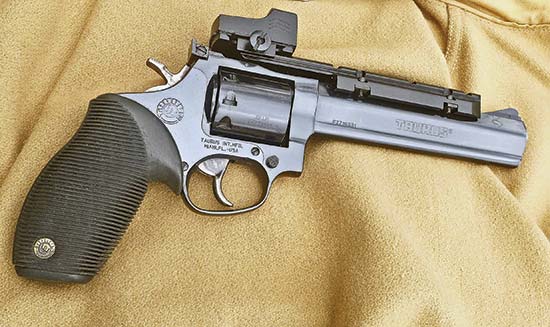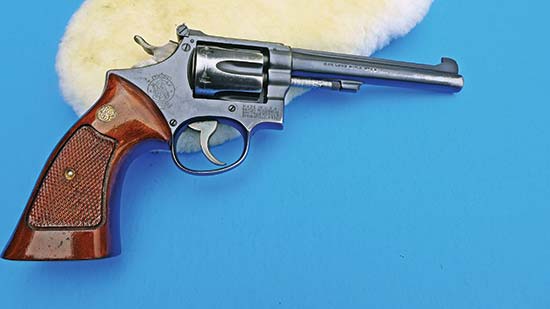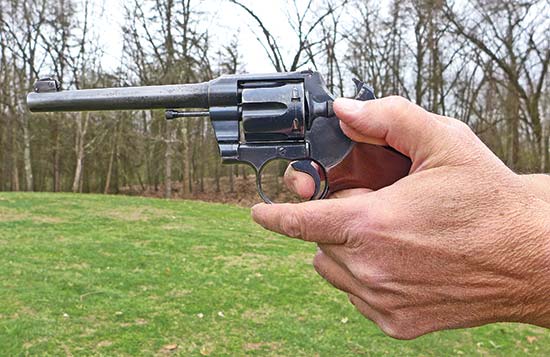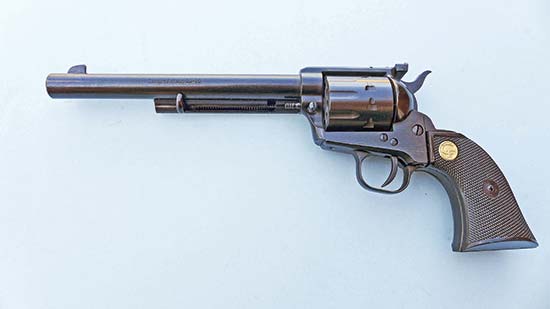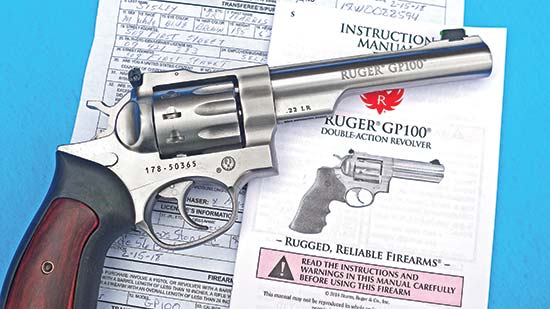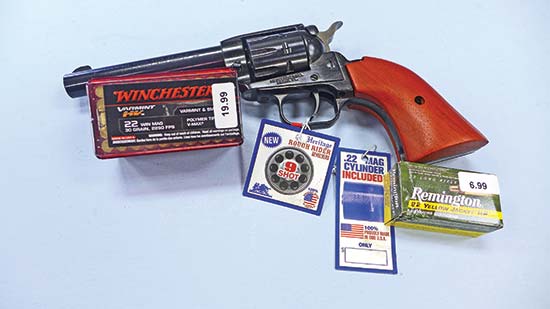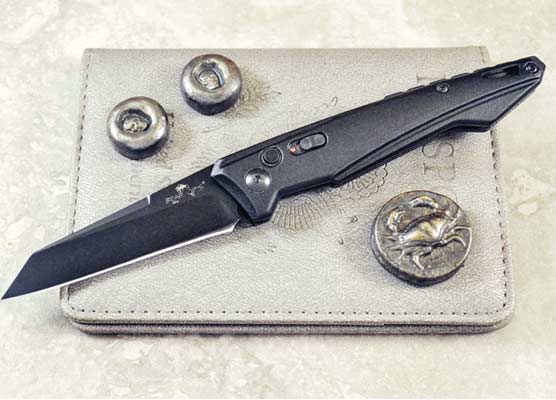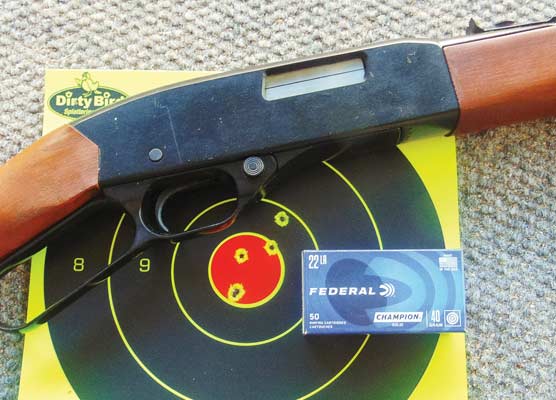A Sixpack Of .22s
Discovering Nirvana — Rimfire Wheelgun Style!
There are millions among us who still love revolvers. But buying centerfire ammo can take a significant chunk out of the family budget. Reloading helps, but .22 Long Rifle ammo still offers the cheapest shooting around — despite the big rimfire price increases in the last several years.
Getting better requires shooting — a lot. Frankly, I only started seeing improvement when I began shooting 100-200 rounds three to five days a week. Some say lots and lots of practice create muscle memory, but muscles don’t have memory, so something else must come into play. Bottom line — the more we shoot the better we get. While most of my .22 shooting involves two-hand offhand practice and what I’d call slow-fire — it pays to practice some faster firing as well — if that’s what you want to learn.
With this in mind, let’s get to six of the revolvers I’ve picked out — some vintage, some current, but all mine and used frequently.
S&W K-22 Masterpiece
Introduced just before World War II, the K-22 Masterpiece replaced the K-22 Outdoorsman — sometimes called the First Model. The Masterpiece has a micro-click adjustable rear sight and a ribbed barrel. The rib added to barrel stiffness and contributed to this classic’s distinctive good looks. I just checked out a pristine K-22 on the Internet for over $1,300. But don’t let the price scare you! Very few of these iconic rimfires are in such near-NIB condition.
Naturally, I bought mine used. It wears the original target grips, and a fair amount of bluing is gone from the barrel and the cylinder. The trigger and the hammer retain their case-hardened finish. But this Smith is golden in the most important aspect. It shoots! Pull the hammer back — check the cylinder tightness — hardly a smidgeon of movement.
According to the serial number this one came out of Springfield around 1962. Some say this was in the heyday of S&W revolver production. This one sports a 6″ barrel (the 4″ was the Combat Masterpiece). The trigger has a clean, no-creep let-off at 3 lbs., 3 oz. Over the years there have been many variations to the K-22, but no matter when made, they’re all good ones. As a dyed-in-the-wool traditionalist, I love shooting this oldie. But I wish I had the original box!
Colt Officer's Model .22
According to the serial number, this one came out of Hartford, Connecticut in 1939. There’s even less bluing on the barrel than my Smith Masterpiece — though the cylinder and frame bluing looks good. More importantly, it’s one of my best shooting handguns — despite being only two years younger than I am.
While I don’t have the original grips (or box) I like the plastic grips because of the thumb rest and “good feel,” athough they do offend my eyes!
The front sight is an insert — which I’ve nail-polished white (easier to see on a black bull). The rear is adjustable — a tiny screw on the right side for windage, one on the top left for elevation. Until Colt came out with the Python, the Colt Officer’s Model Target was the top of their line. Some say this rimfire is the Python — the Officer’s Model .22 action involving so much handwork. The SA trigger pull on my cherished piece of rimfire history? A slick 2 lbs., 15 oz.
Taurus Tracker
This is the Python lookalike with a vent-rib barrel. My .22 Tracker is a blued model, bought new maybe four years ago, but only a stainless steel version remains on the Taurus website. I liked the looks of it when I picked it up at a local gun shop. But then I tried the 3-lb., 5 oz. SA trigger and fell in love.
While my Colt and Smith wear 6″ barrels, Taurus went to 6.5″ on this one. Also, the two previous are 6-shooters. This Taurus is a 9-shot. The gun is blued — but with a case-hardened trigger and hammer.
The grip is delightful — black rubber and cushiony. Although the gun has good adjustable sights, I bought a Burris FastFire 2 Relief Sight — had it mounted on a Taurus rail. These old eyes love the little red dot. And the FastFire sights are small and very lightweight. The gun comes with both .22LR and .22 Magnum cylinders and switching them out is a snap.
The stainless Tracker (Model 992) is available new and at what I think is a very attractive price — especially if you can buy one with a trigger like mine.
Ruger GP100
You don’t have to look hard for a used Ruger GP100 10-shot .22LR as they are still available brand new (mine’s only a few months old). The GP100 is tank-tough and stainless only, but Ruger goes the extra mile in polishing. Many stainless guns come with a matte finish — which saves expense. While I love blued guns, I must admit this highly polished stainless version of the GP100 10-shot certainly grabs my eye.
The sights are a white-outlined fully adjustable rear, married to an easy-to-acquire green fiber-optic front. The front is drift-adjustable — but with the adjustable rear, who needs a drift punch or sight pusher? The grips are soft rubber with walnut inserts — very much the same look as my decades-old .357 GP100. There’s what I call a “mini-rib” atop the 5.5″ barrel. I’m not enthralled with the 5-lb., 10-oz. single-action trigger pull, but it’s pretty much creep-free.
One aspect of the GP100 rimfire I like is the recessed cylinder. My K-22 Smith and Colt Officers Model Target have them as well.
Heritage Arms Rough Rider
The first four revolvers I’ve mentioned are all double-action. But why not a single action? This offering from Heritage Arms is called the “Rough Rider.” Wherever you take it, you won’t have to treat it with kid gloves.
While Heritage has numerous handguns you can peruse, the one shown here is the RR22999MB4 — a .22 LR/.22 Magnum dual-cylinder convertible — both 9-shot capacity. Just in the Rough Rider series alone I count 21 different models. Most involve different finishes, grips and barrel lengths.
These no-nonsense single actions come with very attractive price tags. You’ll probably be able to buy one for less than $250, and they’re made right here in the USA. My specimen sports reddish grips and weighs 30 oz., so it carries for hours in a proper holster with no fatigue. Trigger let-off? About 5 lbs.
Chiappa Target Model Single Action
Chiappa also has a long list of rimfire single actions to choose from. My test gun’s long barrel reminds me of Matt Dillon’s Colt in TV’s Gunsmoke. Chiappa is a family owned business operating out of Italy, with Chiappa USA acting as importer — and based in Dayton, Ohio.
This test gun is blued but has a somewhat gray cast to it. It’s got an adjustable rear sight with the usual clockwise and counter clockwise small screw adjustments. The back sight is black — so aim through a black square “U.” The front sight is a thin blade. Most Chiappa sixguns do not have adjustable sights, so this one is called the Target Model Single Action 22. It comes with two 10-shot cylinders — .22 LR and .22 Magnum. Retail is under $300. The trigger has creep, but the let-off is predictable. On my trigger-pull scale the release is under 4 lbs. Grips are black checkered plastic with a gold Chiappa Firearms medallion.
I had some trouble getting the cylinder to spin for loading and unloading — until I got it figured out. I had to leave the loading gate closed — then pull the hammer to half cock and open the loading gate. (I told you I’m an old timer!) The cylinder then spins easily. Cylinder removal is standard. Push the release at the front left of the frame to pull out the retaining pin and open the loading gate for cylinder removal. I shot this single action extensively in one long session – firing both LRs and mags. There were no malfunctions. Accuracy was acceptable from sandbags at 20 yards – eight shots in a small cluster, two outside it. Probably operator error!
